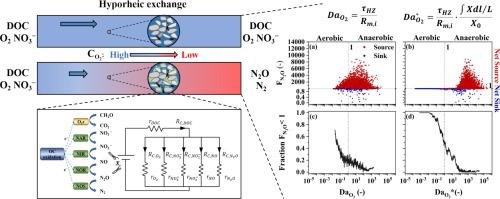当前位置:
X-MOL 学术
›
J. Hydrol.
›
论文详情
Our official English website, www.x-mol.net, welcomes your feedback! (Note: you will need to create a separate account there.)
Effect of microbial growth and electron competition on nitrous oxide source and sink function of hyporheic zones
Journal of Hydrology ( IF 5.9 ) Pub Date : 2024-06-22 , DOI: 10.1016/j.jhydrol.2024.131585 Zhixin Zhang , Yang Xian , Xue Ping , Menggui Jin , Huirong Guo
Journal of Hydrology ( IF 5.9 ) Pub Date : 2024-06-22 , DOI: 10.1016/j.jhydrol.2024.131585 Zhixin Zhang , Yang Xian , Xue Ping , Menggui Jin , Huirong Guo

|
The hyporheic zones (HZs) are key sites of the production of nitrous oxide (NO), a potent ozone-depleting greenhouse gas. Denitrification is the primary process of NO production in HZs, including four reduction steps (NO→NO→NO→NO→N). Electron competition occurs between the four reduction steps and can significantly impact the production of NO. However, denitrification was typically considered as simplified two step reactions for investigating the release of NO, neglecting the electron competition among the four-step reactions. Moreover, the NO production/consumption patterns are regulated by both hydraulic and biogeochemical conditions in HZs. Dynamic microbial growth cannot only mediate the biogeochemical reactions, but also change hydraulic properties spatiotemporally by bioclogging. But microbial growth is rarely considered for investigating NO dynamics of HZs. To assess these effects on hyporheic NO dynamics and source-sink function, we establish a novel numerical model of NO dynamics of HZs, coupling porous flow, reactive transport, electron competition, microbial growth and bioclogging. The results show that the weak electron competitiveness of NO reductase results in a less allocation of electrons to the NO reduction process, particularly in situations with limited carbon sources, thus increasing the release of NO into the rives. Microbial growth significantly influences NO release from HZs into rivers, increasing by more than two orders of magnitude on average compared to the model neglecting microbial dynamics. In contrast to the classical knowledges that HZs in coarse sediments tending to short residence time cannot act as sources of NO, dynamic microbial growth obviously increases the potential for NO release from HZs in coarse sediments to the rivers. The global Monte Carlo regional sensitivity analyses indicate that microbial biomass is the most critical factor determined the hyporheic source-sink function for NO, followed by carbon oxidation rate and residence time. These are significantly different from previous knowledge that the residence time and oxygen/nitrogen uptake rate are the most sensitive parameters, which may lead to misunderstanding of the key controlling factors of NO release from HZs. In addition, we propose a new Damköhler number () of dissolved oxygen by multiplying the classical with a dimensionless microbial modification factor for identifying NO source-sink function of HZs, with < 1 for NO sink, while > 1 for NO source.
中文翻译:

微生物生长和电子竞争对潜流带一氧化二氮源库功能的影响
潜流区 (HZ) 是一氧化二氮 (NO) 产生的关键场所,一氧化二氮 (NO) 是一种强效消耗臭氧层的温室气体。反硝化是HZs中NO产生的主要过程,包括四个还原步骤(NO→NO→NO→NO→N)。四个还原步骤之间会发生电子竞争,并且会显着影响 NO 的产生。然而,反硝化通常被认为是研究 NO 释放的简化两步反应,忽略了四步反应之间的电子竞争。此外,NO 的生产/消耗模式受到 HZ 水力和生物地球化学条件的调节。微生物的动态生长不仅可以介导生物地球化学反应,还可以通过生物堵塞在时空上改变水力特性。但在研究 HZ 的 NO 动态时很少考虑微生物生长。为了评估这些对潜流 NO 动力学和源汇功能的影响,我们建立了一种新颖的 HZ NO 动力学数值模型,耦合多孔流、反应输运、电子竞争、微生物生长和生物堵塞。结果表明,NO 还原酶的电子竞争力较弱,导致分配给 NO 还原过程的电子较少,特别是在碳源有限的情况下,从而增加了 NO 向河流的释放。微生物生长显着影响从 HZ 到河流的 NO 释放,与忽略微生物动态的模型相比,平均增加了两个数量级以上。与传统观点认为,停留时间较短的粗沉积物中的 HZ 不能作为 NO 源,动态微生物生长明显增加了粗沉积物中的 HZ 向河流释放 NO 的潜力。 全球蒙特卡罗区域敏感性分析表明,微生物量是决定NO流源汇功能的最关键因素,其次是碳氧化速率和停留时间。这些与之前的认识显着不同,即停留时间和氧/氮吸收率是最敏感的参数,这可能会导致对HZ释放NO的关键控制因素的误解。此外,我们提出了一个新的溶解氧 Damköhler 数 (),通过将经典值乘以无量纲微生物修正因子来识别 HZ 的 NO 源库功能,其中 < 1 表示 NO 汇,而 > 1 表示 NO 源。
更新日期:2024-06-22
中文翻译:

微生物生长和电子竞争对潜流带一氧化二氮源库功能的影响
潜流区 (HZ) 是一氧化二氮 (NO) 产生的关键场所,一氧化二氮 (NO) 是一种强效消耗臭氧层的温室气体。反硝化是HZs中NO产生的主要过程,包括四个还原步骤(NO→NO→NO→NO→N)。四个还原步骤之间会发生电子竞争,并且会显着影响 NO 的产生。然而,反硝化通常被认为是研究 NO 释放的简化两步反应,忽略了四步反应之间的电子竞争。此外,NO 的生产/消耗模式受到 HZ 水力和生物地球化学条件的调节。微生物的动态生长不仅可以介导生物地球化学反应,还可以通过生物堵塞在时空上改变水力特性。但在研究 HZ 的 NO 动态时很少考虑微生物生长。为了评估这些对潜流 NO 动力学和源汇功能的影响,我们建立了一种新颖的 HZ NO 动力学数值模型,耦合多孔流、反应输运、电子竞争、微生物生长和生物堵塞。结果表明,NO 还原酶的电子竞争力较弱,导致分配给 NO 还原过程的电子较少,特别是在碳源有限的情况下,从而增加了 NO 向河流的释放。微生物生长显着影响从 HZ 到河流的 NO 释放,与忽略微生物动态的模型相比,平均增加了两个数量级以上。与传统观点认为,停留时间较短的粗沉积物中的 HZ 不能作为 NO 源,动态微生物生长明显增加了粗沉积物中的 HZ 向河流释放 NO 的潜力。 全球蒙特卡罗区域敏感性分析表明,微生物量是决定NO流源汇功能的最关键因素,其次是碳氧化速率和停留时间。这些与之前的认识显着不同,即停留时间和氧/氮吸收率是最敏感的参数,这可能会导致对HZ释放NO的关键控制因素的误解。此外,我们提出了一个新的溶解氧 Damköhler 数 (),通过将经典值乘以无量纲微生物修正因子来识别 HZ 的 NO 源库功能,其中 < 1 表示 NO 汇,而 > 1 表示 NO 源。











































 京公网安备 11010802027423号
京公网安备 11010802027423号